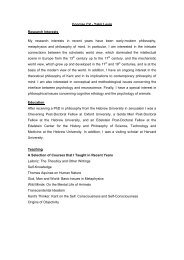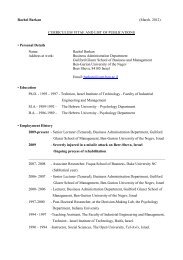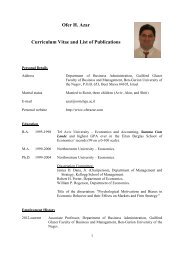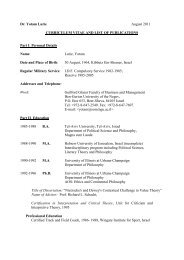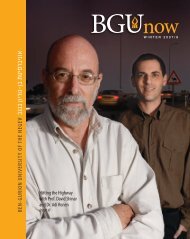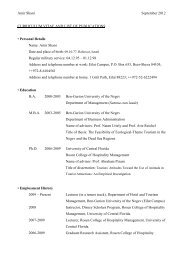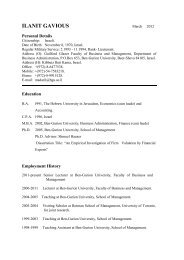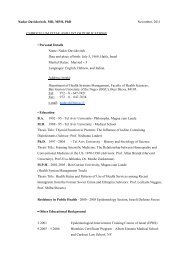Book of Abstracts
Book of Abstracts
Book of Abstracts
Create successful ePaper yourself
Turn your PDF publications into a flip-book with our unique Google optimized e-Paper software.
Uncertain ecosystems: the ecology <strong>of</strong> open, non-forested vegetation<br />
William J. Bond, Botany Department, University <strong>of</strong> Cape Town, Private Bag, Rondebosch, 7701, South Africa;<br />
william.bond@uct.ac.za<br />
46<br />
Climate has long been considered the prime factor determining the distribution <strong>of</strong> major vegetation formations<br />
implying that there is a single stable vegetation state for a given climate. However this is not true for large parts <strong>of</strong><br />
the world where strikingly different vegetation states, such as forests and grasslands, occur in the same landscapes<br />
under the same climate. For most <strong>of</strong> the last century the non-forested (‘open’) ecosystems were thought to be<br />
secondary vegetation produced by deforestation and anthropogenic burning. However open ecosystems include<br />
some <strong>of</strong> the world's richest biodiversity hotspots, implying a long evolutionary history. Recent fossil and<br />
phylogenetic evidence supports their antiquity while Quaternary studies are showing that some open ecosystems<br />
were even more extensive before the rise <strong>of</strong> human populations. Recognition <strong>of</strong> the age and extent <strong>of</strong> open<br />
ecosystems challenges traditional ecological concepts. Succession, driven by competition for resources and<br />
especially light, should result in dominance <strong>of</strong> taller- shade-tolerant growth forms where resources permit. Yet open<br />
ecosystems dominated by low-growing plants have persisted for millions <strong>of</strong> years. Recurrent disturbance, especially<br />
by fire, but also by large vertebrate herbivores, is important in maintaining open ecosystem states. Though<br />
understanding <strong>of</strong> the global importance <strong>of</strong> fire has grown rapidly in the last decade, there are still many uncertainties<br />
about the importance <strong>of</strong> mammals in creating and maintaining open ecosystems, both now and in the past.<br />
Recognition <strong>of</strong> the global extent <strong>of</strong> uncertain ecosystems, and <strong>of</strong> factors maintaining open ecosystems, is essential<br />
for understanding future global change <strong>of</strong> terrestrial vegetation.<br />
Fragmentation and biodiversity patterns in fragmented semi-arid landscapes<br />
Yoni Gavish; Ben-Gurion University <strong>of</strong> the Negev, POB 653, Beer-Sheva, 84105, Israel; gavishyoni@gmail.com<br />
Yaron Ziv; Ben-Gurion University <strong>of</strong> the Negev, POB 653, Beer-Sheva, 84105, Israel; yziv@bgu.ac.il<br />
Two main processes that drive the current global biodiversity crisis are global climate change and the transformation<br />
<strong>of</strong> natural habitats into human dominated land-uses (habitat loss). As human settlements and agricultural practice in<br />
desert environments are relatively scarce, the world’s deserts have experienced relatively low levels <strong>of</strong> habitat loss.<br />
As such, the effects <strong>of</strong> habitat loss and fragmentation on desert systems are relatively unexplored. In contrast, semiarid<br />
landscapes, which lie at the edge <strong>of</strong> the world’s desert belt, have already been subjected to high levels <strong>of</strong> habitat<br />
loss and fragmentation. We have sampled spiders in three fragmented semi-arid landscapes along the sharp climatic<br />
gradient <strong>of</strong> Israel. Various methods to decouple fragmentation from habitat loss reveal that fragmentation actually<br />
maximizes diversity. We explain this result using an occupancy-based null model for the species-area relationship.<br />
The null-model reveals that rare species are found on small patches more than expected by chance. We further<br />
develop the link between occupancies and species-area relationship to theoretically explore the effect <strong>of</strong><br />
fragmentation on species diversity. This exploration reveals that when the evenness <strong>of</strong> the distribution <strong>of</strong> area<br />
between patches is low, fragmented landscapes will sustain higher species diversity than continuous landscapes. We<br />
suggest that if we wish to understand how climate change and human effects influence biodiversity, we should apply<br />
quantitative models and methods in order to recognize underlying mechanisms.<br />
Elimination <strong>of</strong> predators is a sufficient condition for steppification<br />
Lauri Oksanen 1,2 - lauoks@utu.fi, Tarja Oksanen 1,2 and Risto Virtanen 3<br />
1 Department <strong>of</strong> Biology, section <strong>of</strong> Ecology, University <strong>of</strong> Turku, FI-20014 Turku, Finland<br />
2 Section <strong>of</strong> Sciences, Finnmark University College, Alta, NO-9504 Alta, Norway<br />
3 Department <strong>of</strong> Biology, University <strong>of</strong> Oulu, FI-90014 Oulu, Finland<br />
During the last three millennia, vast forested areas have changed into treeless communities, dominated by<br />
graminoids or prostrate dicots. Sometimes the vegetation has become scanty enough to warrant the term<br />
desertification, but in most cases, steppification is a more appropriate term, since even in the new state, > 50% <strong>of</strong><br />
ground is covered by plants.



